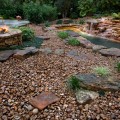What are the best drought resist
What are the best drought resistant plants?
Drought resistant plants are those that in one form or fashion have evolved the ability to withstand longer periods of time during which there is no rain. All classifications of plants contain species that have these qualities, making it possible for Exterior Worlds professionals to develop an entirely drought resistant landscape consisting of ornamental grasses, ground covers, flowers, shrubs, and trees.
Plants that are marketed as possessing this resilience are often described as either “drought resistant” or “drought tolerant” by garden centers, which often use the terms interchangeably. This can confuse do-it-yourself landscaper who may not have the time to research the exact botanical quantities of the vegetation they wish to add to their yard.
Working with a team of professionals will ensure that the drought resistant plants that are used in your Houston landscaping design will perform as you expect them to without losing their vitality or curb appeal in the event of an extended dry spell.
Without getting too technical as to what the term “drought resistant” botanically means, essentially what we are talking about here is the way that the plants respond to the threat of dehydration. In residential Houston landscaping design, we typically use species that feature both dehydration avoidance and a low dehydration quantity.
Dehydration avoidance refers to the ability of vegetation to remain green and maintain its turgidity in the event of low rainfall and summer heat. Many drought resistant grasses have this characteristic, such as Zoysia and Bermuda, which are known to retain their color in the hottest months of August and September. Many ground covers which are also classified as drought resistant plants also have this quality.
Ideally, plants with strong dehydration avoidance should also have a low dehydration quantity. This quantity refers to the minimal amount of water and the frequency that it is needed by lawn grass, drought resistant trees, drought resistant flowers, and drought resistant shrubs. Many plants with a low dehydration quantity can be watered every two weeks or even every month with only a moderate amount of water and still retain their turgidity and color.
The obvious economic benefit to landscaping with drought resistant plants is twofold. On the immediate front, saving on the cost of water represents a sizeable amount of money for the homeowner facing an extended hot, dry summer. Through a custom irrigation system built by Exterior Worlds, only the necessary amounts of water are transported to lawn grass, gardens, and accent softscapes using a delivery system timed to coincide with the needs of the specific plants we install.
Drought resistant landscaping also helps differentiate your home with superior curb appeal, which can increase your property value over the years to come. There are many types of popular garden designs which work extremely well with drought resistant plants. Chief among them are modern gardens and contemporary gardens, which can often be planted using exclusively native species that are ecologically beneficial to our local environment.
Mediterranean landscapes are also known to do exceptionally well with plants accustomed to semi-arid or arid conditions because plants from this part of the world typically have the right blend of dehydration avoidance and low dehydration quantity to make them adaptable to our environment.

